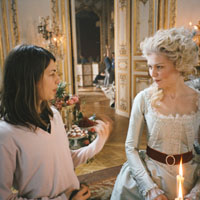Interview: Sofia Coppola

Much has been made of Sofia Coppola’s rock music version of Marie Antoinette. Using a modern soundtrack means this could either be Moulin Rouge! or A Knight’s Tale. Now that it’s public knowledge, indeed part of the marketing campaign, no history buffs should complain. Coppola even uses the opening shot to put her stamp on the film, showing Kirsten Dunst as the queen lounging in indifference as a drum beats away.
“I had that in the script from the beginning,” she said. “I wanted to show here’s what we think of Marie Antoinette and then tell you that this is the real story.”
Aside from a few anachronisms, Marie Antoinette is still a historically accurate biography. It’s also a distinctly Sofia Coppola film with sparse dialogue and many visual pauses.
“I always in that first section wanted to kind of feel the atmosphere and get the impression of her emotions just by her expressions and have this sort of intimate feeling and not explain things through dialogue, but just to kind of be with her and be experiencing it through what she’s seeing and then her emotions. So I just like telling things in that way, more in a visually driven way.”
Coppola also manipulates the colors of the film, keeping things gray and overcast as Marie’s youth is stifled by her royal obligations and livening up as she puts her stamp on French history.
“The color palette all came from creating the world of this young girl. When I saw her real apartments of Marie Antoinette I was struck by the colors that she had apparently chosen of turquoise fabric and pink flowers, so I wanted the color palette to reflect that and her world and what would a 14 year old girl pick? But also to feel the vitality that they’re all alive at this time as opposed to some kind of sepia distance of looking at history. And just the brightness of the colors that you’re not referencing the paintings that have been faded over the years but it has the brightness of them being alive at that time. And from what her kind of taste was.”
Marie Antoinette is Coppola’s biggest film, after two indies, and her first time working with a major studio, Columbia Pictures. “I’d never worked with a studio on the production level and I was surprised. I think for them it’s probably a smaller film compared to the others but they were really just ‘go make it your way.’ They didn’t get involved in the casting or on the set. I’ve heard stories of that.”
CINEMABLEND NEWSLETTER
Your Daily Blend of Entertainment News
Indeed, Coppola’s epic was modest for the Spider-Man studio. “Our budget was around $40 million but I tried to keep the budget as low as possible with what we needed to accomplish just so I could have that creative freedom which is important to me. I wouldn’t have gone into a situation where I didn’t have creative freedom.”
You’d think after two acclaimed films, people would stop asking Coppola about her father, but it still happens and she takes it well. “I’m not calling him going, ‘What do I do?’ No, he’s like a mentor to me so a lot of times in the pre-production, I’ll talk to him about the crew I’m putting together and ask his advice or when I’m editing, I’ll show him an early cut and get his advice. So in that way, he’s available to me. He just always encouraged me to make the movies much in my personality and do it in my own unique way, so he always pushed me to make it as personal as possible.”
Her third film, Marie Antoinette, opens Friday.

After Law And Order: SVU Gave Carisi The 'Wake-Up Call' He Needed, Peter Scanavino Talked Filming His Most Emotional Moments With Mariska Hargitay

After SNL50: Beyond Saturday Night Dug Deep Into Will Ferrell's Iconic Cowbell Sketch, The EP Discussed Tracking Down Old Footage: 'Somebody Had A VHS Tape'
Most Popular






